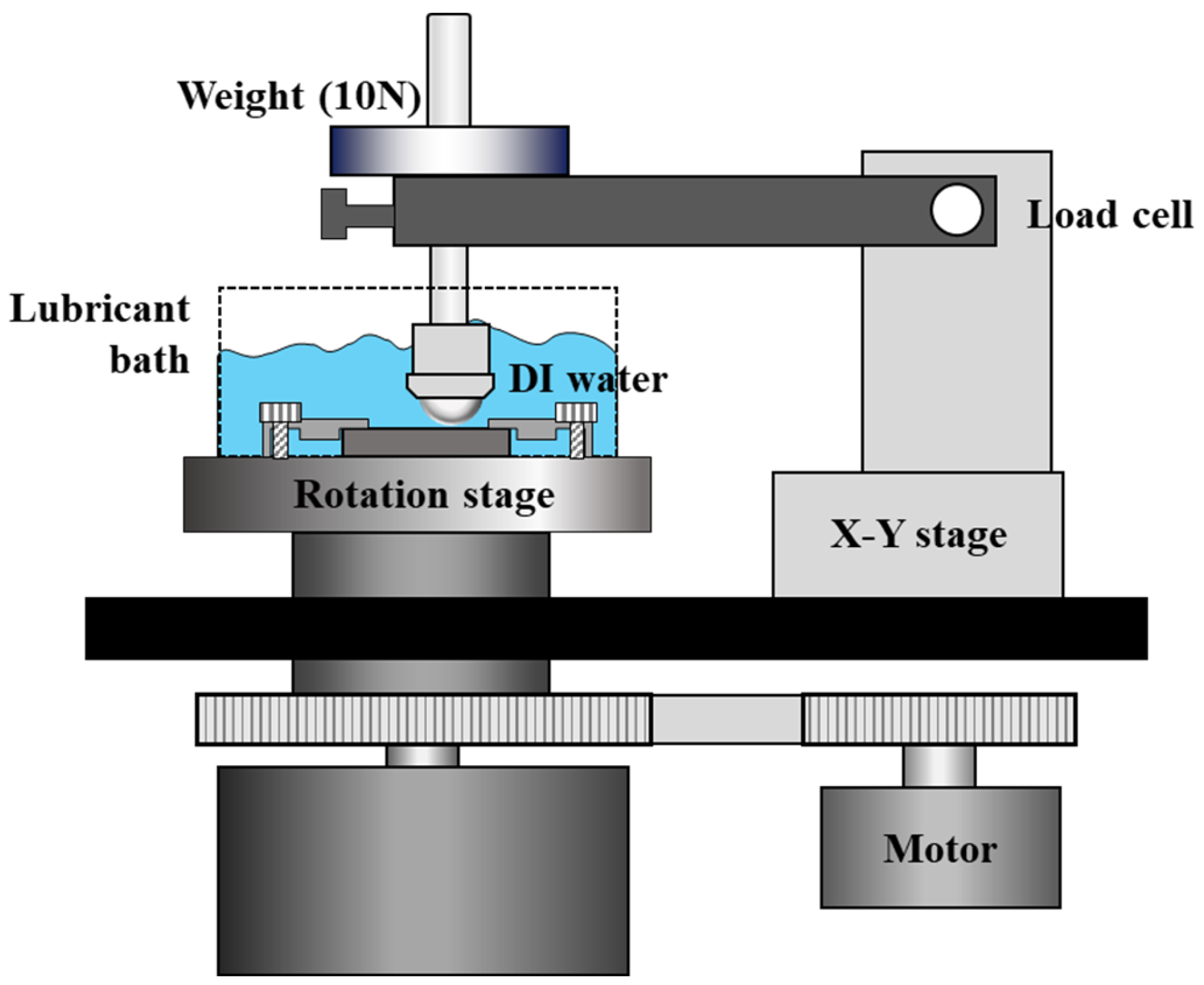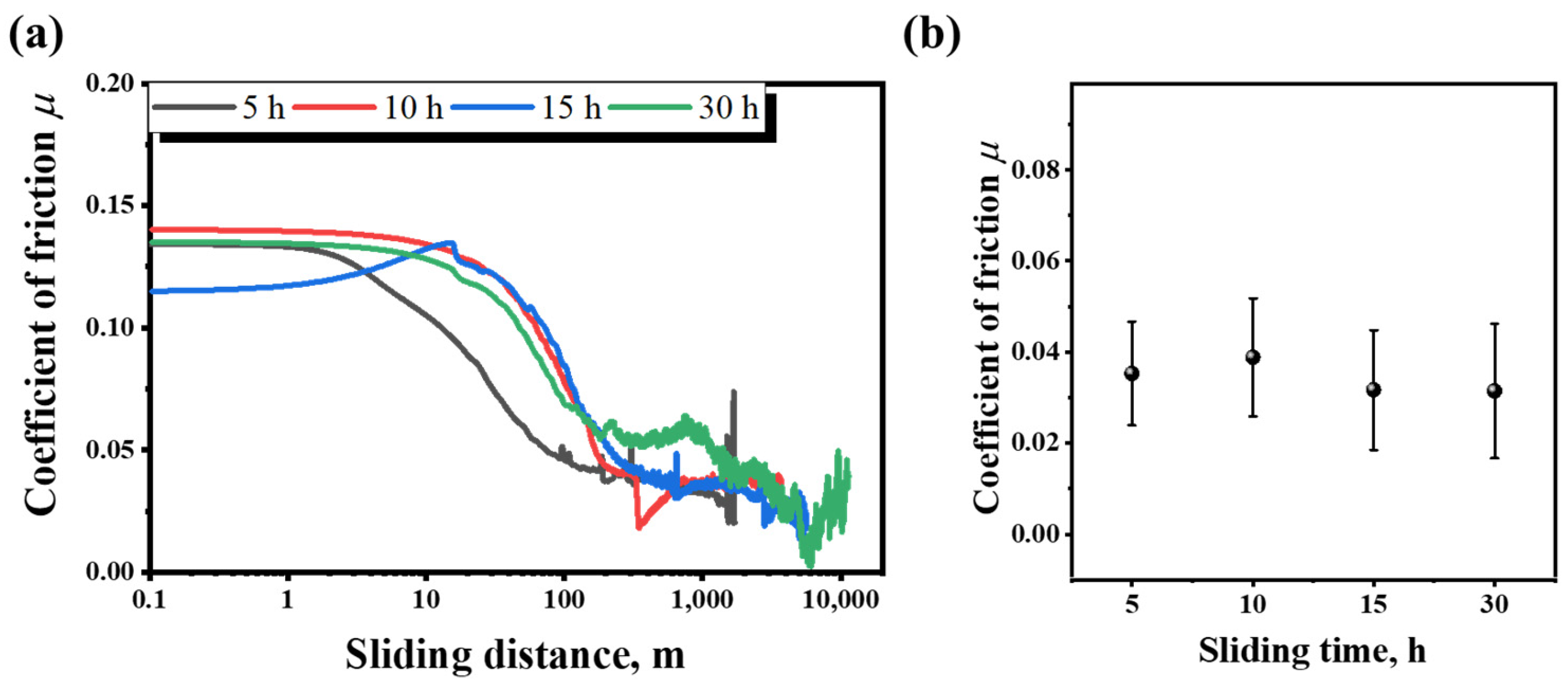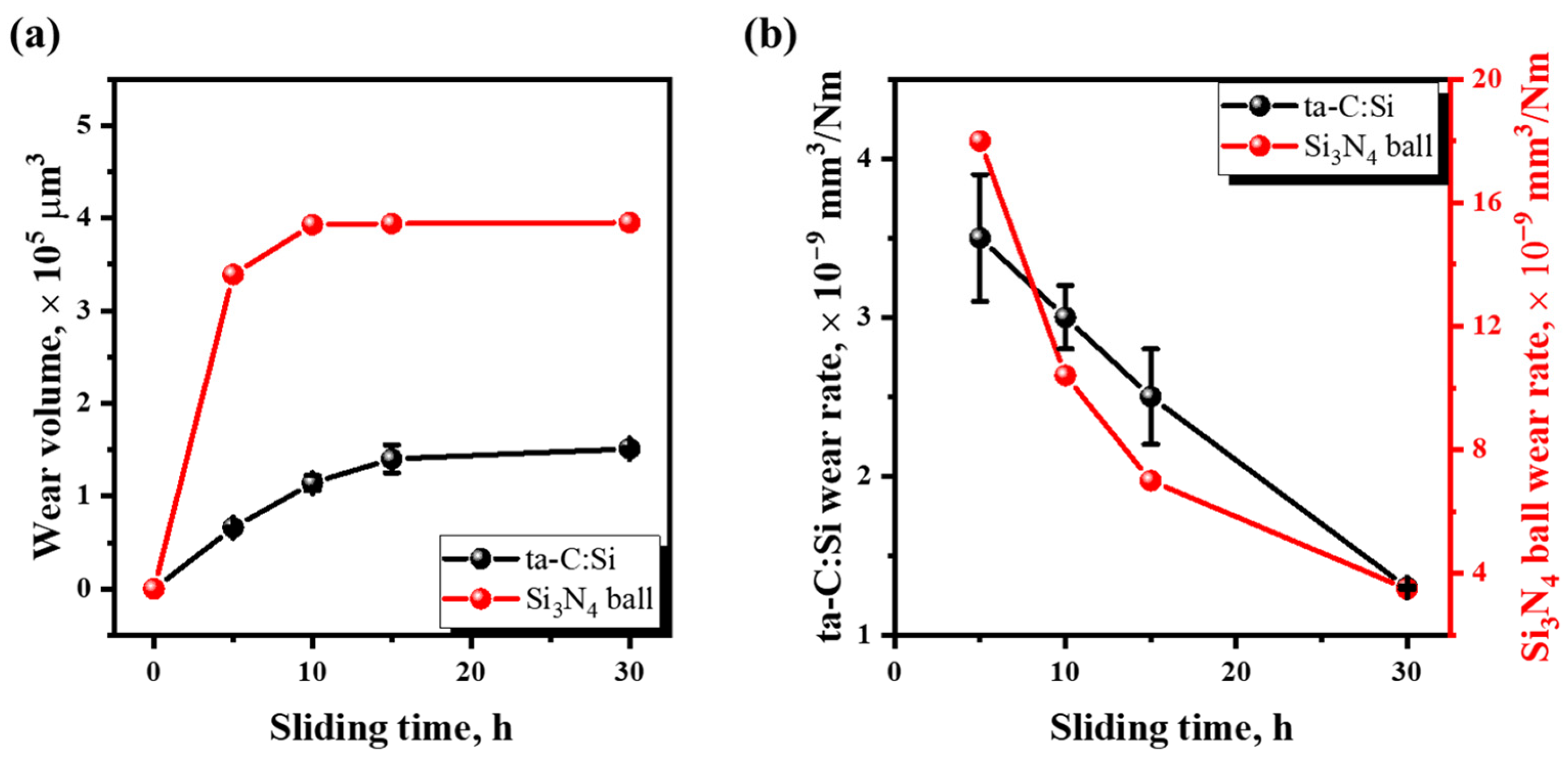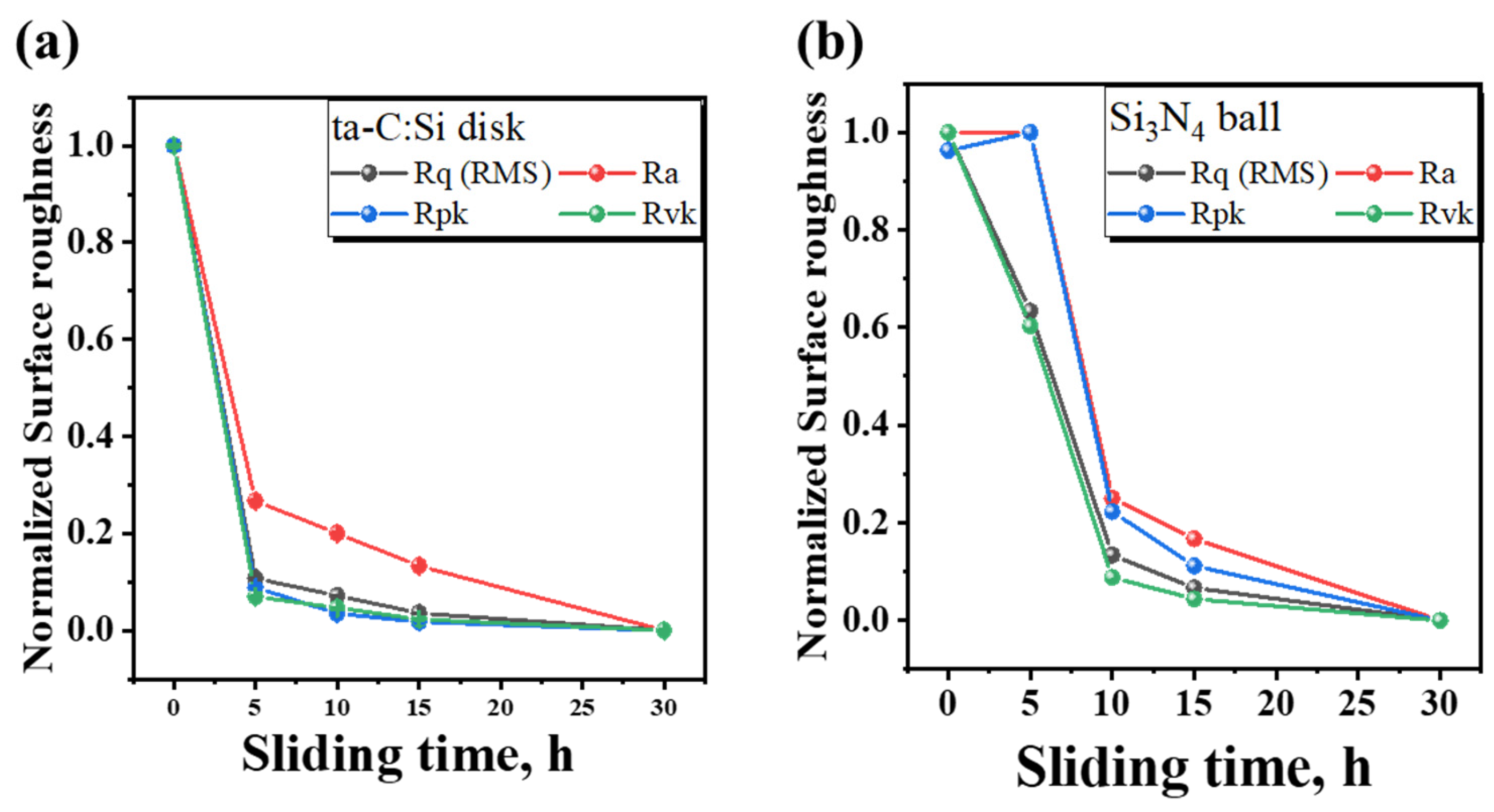Wear Transition of Silicon-Doped Tetrahedral Amorphous Carbon (ta-C:Si) Under Water Lubrication
Abstract
1. Introduction
2. Materials and Methods
2.1. Coating Preparation
2.2. Characterization
3. Results and Discussion
3.1. Friction Characteristics
3.2. Wear Behavior
3.3. Discussion: Comparison with Archard Wear Equation
3.4. Discussion: Relationship with Plasticity Index
4. Conclusions
- -
- The surface roughness became smoother as the wear volume of the ta-C:Si coating decreased. This suggests a close relationship between the wear coefficient K of the Archard wear equation and surface roughness evolution.
- -
- From the perspective of the plasticity index in contact mechanics, the wear rate was the highest in the fully plastic contact state, and decreased by about 30% once the contact state became fully elastic (ψ ≤ 0.6).
- -
- From the relationship between the wear coefficient and the plasticity index, the steady-state wear rate can be defined starting from the point where the contact state becomes fully elastic.
- -
- This suggests that, in hard coatings including ta-C:Si, once the fully elastic contact is established, the wear proceeds in a more linear and predictable manner, which enables a more consistent analysis and evaluation of wear behavior.
Author Contributions
Funding
Institutional Review Board Statement
Informed Consent Statement
Data Availability Statement
Conflicts of Interest
References
- Rahman, M.H.; Warneke, H.; Webbert, H.; Rodriguez, J.; Austin, E.; Tokunaga, K.; Rajak, D.K.; Menezes, P.L. Water-Based Lubricants: Development, Properties, and Performances. Lubricants 2021, 9, 73. [Google Scholar] [CrossRef]
- Chen, M.; Kato, K.; Adachi, K. Friction and Wear of Self-Mated SiC and Si3N4 Sliding in Water. Wear 2001, 250, 246–255. [Google Scholar] [CrossRef]
- Wu, X.; Suzuki, M.; Ohana, T.; Tanaka, A. Characteristics and Tribological Properties in Water of Si-DLC Coatings. Diam. Relat. Mater. 2008, 17, 7–12. [Google Scholar] [CrossRef]
- Kim, J.I.; Jang, Y.J.; Kim, J.; Kim, J. Effects of Silicon Doping on Low-Friction and High-Hardness Diamond-like Carbon Coating via Filtered Cathodic Vacuum Arc Deposition. Sci. Rep. 2021, 11, 3529. [Google Scholar] [CrossRef] [PubMed]
- Huang, W.; Xu, Y.; Zheng, Y.; Wang, X. The Tribological Performance of Ti(C,N)-Based Cermet Sliding against Si3N4 in Water. Wear 2011, 4, 682–687. [Google Scholar] [CrossRef]
- McKenzie, D.R. Tetrahedral Bonding in Amorphous Carbon. Rep. Prog. Phys. 1996, 59, 1611–1664. [Google Scholar] [CrossRef]
- Sutton, D.C.; Limbert, G.; Stewart, D.; Wood, R.J.K. The Friction of Diamond-like Carbon Coatings in a Water Environment. Friction 2013, 1, 210–221. [Google Scholar] [CrossRef]
- Ronkainen, H.; Varjus, S.; Holmberg, K. Tribological Performance of Different DLC Coatings in Water-Lubricated Conditions. Wear 2001, 249, 267–271. [Google Scholar] [CrossRef]
- Wang, Q.; Zhou, F. Progress in Tribological Properties of Nano-Composite Hard Coatings under Water Lubrication. Lubricants 2017, 17, 5. [Google Scholar] [CrossRef]
- Kim, M.G.; Lee, K.R.; Eun, K.Y. Tribological Behavior of Silicon-Incorporated Diamond-like Carbon Films. Surf. Coat. Technol. 1999, 112, 204–209. [Google Scholar] [CrossRef]
- Camargo, S.S.; Gomes, J.R.; Carrapichano, J.M.; Silva, R.F.; Achete, C.A. Silicon-Incorporated Diamond-like Coatings for Si3N4 Mechanical Seals. Thin Solid Film. 2005, 482, 221–225. [Google Scholar] [CrossRef]
- Yang, S.H.; Kong, H.; Lee, K.R.; Park, S.; Kim, D.E. Effect of Environment on the Tribological Behavior of Si-Incorporated Diamond-like Carbon Films. Wear 2002, 252, 70–79. [Google Scholar] [CrossRef]
- Takikawa, H.; Tanoue, H. Review of Cathodic Arc Deposition for Preparing Droplet-Free Thin Films. In Proceedings of the IEEE Transactions on Plasma Science, Online, 13 August 2007; Volume 35, pp. 992–999. [Google Scholar]
- Fujii, Y.; Imai, T.; Miyamoto, Y.; Ueda, N.; Hosoo, M.; Harigai, T.; Suda, Y.; Takikawa, H.; Tanoue, H.; Kamiya, M.; et al. Dry Machining of Metal Using an Engraving Cutter Coated with a Droplet-Free Ta-C Film Prepared via a T-Shape Filtered Arc Deposition. Surf. Coat. Technol. 2016, 307, 1029–1033. [Google Scholar] [CrossRef]
- Lee, W.Y.; Jang, Y.J.; Tokoroyama, T.; Murashima, M.; Umehara, N. Effect of Defects on Wear Behavior in Ta-C Coating Prepared by Filtered Cathodic Vacuum Arc Deposition. Diam. Relat. Mater. 2020, 105, 107789. [Google Scholar] [CrossRef]
- Jang, Y.J.; Kim, J.I.; Lee, W.Y.; Kim, J. Friction Properties of Thick Tetrahedral Amorphous Carbon Coating with Different Surface Defects under Dry Contact Conditions. Appl. Surf. Sci. 2021, 550, 149332. [Google Scholar] [CrossRef]
- Deng, Y.; Chen, W.; Li, B.; Wang, C.; Kuang, T.; Li, Y. Physical Vapor Deposition Technology for Coated Cutting Tools: A Review. Ceram. Int. 2020, 46, 18373–18790. [Google Scholar] [CrossRef]
- Sun, L.; Li, Y.; Cao, C.; Bi, G.; Luo, X. Effect of Low-Temperature Plasma Carburization on Fretting Wear Behavior of AISI 316L Stainless Steel. Coatings 2024, 14, 158. [Google Scholar] [CrossRef]
- Kim, W.-S.; Kim, S.; Jang, Y.-J.; Kim, J. A Study on the Wear Behavior of Tetrahedral Amorphous Carbon Coatings Based on Bending Angles of the Filtered Cathodic Vacuum Arc with Different Arc Discharge Currents. Tribol. Lubr. 2022, 38, 101–108. [Google Scholar] [CrossRef]
- Archard, J.F.; Hirst, W. The Wear of Metals under Unlubricated Conditions. Proc. R. Soc. London. Ser. A. Math. Phys. Sci. 1956, 236, 397–410. [Google Scholar] [CrossRef]
- Alhadeff, L.; Marshall, M.; Slatter, T. The Influence of Tool Coating on the Length of the Normal Operating Region (Steady-State Wear) for Micro End Mills. Precis. Eng. 2019, 60, 306–319. [Google Scholar] [CrossRef]
- Blau, P.J. Interpretations of the Friction and Wear Break-in Behavior of Metals in Sliding Contact. Wear 1981, 71, 29–43. [Google Scholar] [CrossRef]
- Blau, P.J. On the Nature of Running-In. Tribol. Int. 2005, 38, 1007–1012. [Google Scholar] [CrossRef]
- Blau, P.J. How Common Is the Steady-State? The Implications of Wear Transitions for Materials Selection and Design. Wear 2015, 332–333, 1120–1128. [Google Scholar] [CrossRef]
- Jang, Y.J.; Kim, J.I.; Kim, W.S.; Kim, D.H.; Kim, J. Thermal Stability of Si/SiC/Ta-C Composite Coatings and Improvement of Tribological Properties through High-Temperature Annealing. Sci. Rep. 2022, 12, 3536. [Google Scholar] [CrossRef]
- Zawischa, M.; Makowski, S.; Krülle, T.; Weihnacht, V. Structural Changes of Doped Ta-C Coatings at Elevated Temperature. Carbon N.Y. 2023, 213, 118182. [Google Scholar] [CrossRef]
- Byon, S.-M. Experimental Study to Examine Wear Characteristics and Determine the Wear Coefficient of Ductile Cast Iron (DCI) Roll. J. Korean Soc. Tribol. Lubr. Eng. 2017, 33, 98–105. [Google Scholar] [CrossRef]
- Domínguez García, S.; Béjar Gómez, L.; Maya Yescas, R.; Lara Romero, J.; Castro Cedeño, B.; Espinosa Medina, M.A. Friction Coefficient Dynamics of Tribological Coatings from Engine Lubricants: Analysis and Interpretation. Coatings 2023, 10, 1753. [Google Scholar] [CrossRef]
- Ghatrehsamani, S.; Akbarzadeh, S. Predicting the wear coefficient and friction coefficient in dry point contact using continuum damage mechanics. Proc. Inst. Mech. Eng. Part J 2018, 233, 447–455. [Google Scholar] [CrossRef]
- Ghosh, A.; Sadeghi, F. A novel approach to model effects of surface roughness parameters on wear. Wear 2015, 338, 338–339. [Google Scholar] [CrossRef]
- Janakiraman, V.; Li, S.; Kahraman, A. An Investigation of the Impacts of Contact Parameters on Wear Coefficient. J. Tribol. 2014, 136, 031602-1. [Google Scholar] [CrossRef]
- Sedlaček, M.; Podgornik, B.; Vižintin, J. Influence of Surface Preparation on Roughness Parameters, Friction and Wear. Wear 2009, 266, 482–487. [Google Scholar] [CrossRef]
- Greenwood, J.A.; Williamson, J.B.P. Contact of Nominally Flat Surfaces. Proc. R. Soc. London. Ser. A. Math. Phys. Sci. 1966, 295, 300–319. [Google Scholar] [CrossRef]
- Kogut, L.; Etsion, I. A Static Friction Model for Elastic-Plastic Contacting Rough Surfaces. J. Tribol. 2004, 126, 34–40. [Google Scholar] [CrossRef]
- Beake, B.D. The Influence of the H/E Ratio on Wear Resistance of Coating Systems—Insights from Small-Scale Testing. Surf. Coat. Technol. 2022, 442, 128272. [Google Scholar] [CrossRef]
- Chowdhury, M.S.I.; Bose, B.; Rawal, S.; Fox-Rabinovich, G.S.; Veldhuis, S.C. Investigation of the Wear Behavior of Pvd Coated Carbide Tools during Ti6al4v Machining with Intensive Built up Edge Formation. Coatings 2021, 11, 266. [Google Scholar] [CrossRef]








Disclaimer/Publisher’s Note: The statements, opinions and data contained in all publications are solely those of the individual author(s) and contributor(s) and not of MDPI and/or the editor(s). MDPI and/or the editor(s) disclaim responsibility for any injury to people or property resulting from any ideas, methods, instructions or products referred to in the content. |
© 2025 by the authors. Licensee MDPI, Basel, Switzerland. This article is an open access article distributed under the terms and conditions of the Creative Commons Attribution (CC BY) license (https://creativecommons.org/licenses/by/4.0/).
Share and Cite
Kim, J.-I.; Jang, J.-W.; Kim, M.H.; Kwon, S.-H.; Jang, Y.-J. Wear Transition of Silicon-Doped Tetrahedral Amorphous Carbon (ta-C:Si) Under Water Lubrication. Coatings 2025, 15, 640. https://doi.org/10.3390/coatings15060640
Kim J-I, Jang J-W, Kim MH, Kwon S-H, Jang Y-J. Wear Transition of Silicon-Doped Tetrahedral Amorphous Carbon (ta-C:Si) Under Water Lubrication. Coatings. 2025; 15(6):640. https://doi.org/10.3390/coatings15060640
Chicago/Turabian StyleKim, Jae-Il, Ji-Woong Jang, Myung Hyun Kim, Se-Hun Kwon, and Young-Jun Jang. 2025. "Wear Transition of Silicon-Doped Tetrahedral Amorphous Carbon (ta-C:Si) Under Water Lubrication" Coatings 15, no. 6: 640. https://doi.org/10.3390/coatings15060640
APA StyleKim, J.-I., Jang, J.-W., Kim, M. H., Kwon, S.-H., & Jang, Y.-J. (2025). Wear Transition of Silicon-Doped Tetrahedral Amorphous Carbon (ta-C:Si) Under Water Lubrication. Coatings, 15(6), 640. https://doi.org/10.3390/coatings15060640








